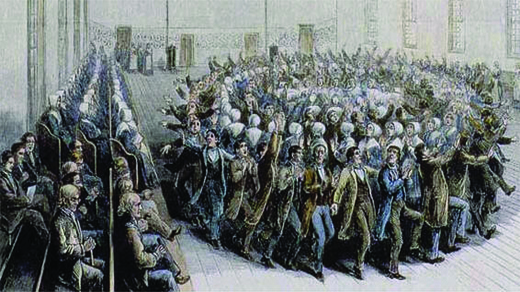| << Chapter < Page | Chapter >> Page > |
The Shakers provide another example of a community established with a religious mission. The Shakers started in England as an outgrowth of the Quaker religion in the middle of the eighteenth century. Ann Lee, a leader of the group in England, emigrated to New York in the 1770s, having experienced a profound religious awakening that convinced her that she was “mother in Christ.” She taught that God was both male and female; Jesus embodied the male side, while Mother Ann (as she came to be known by her followers) represented the female side. To Shakers in both England and the United States, Mother Ann represented the completion of divine revelation and the beginning of the millennium of heaven on earth.
In practice, men and women in Shaker communities were held as equals—a radical departure at the time—and women often outnumbered men. Equality extended to the possession of material goods as well; no one could hold private property. Shaker communities aimed for self-sufficiency, raising food and making all that was necessary, including furniture that emphasized excellent workmanship as a substitute for worldly pleasure.
The defining features of the Shakers were their spiritual mysticism and their prohibition of sexual intercourse, which they held as an example of a lesser spiritual life and a source of conflict between women and men. Rapturous Shaker dances, for which the group gained notoriety, allowed for emotional release ( [link] ). The high point of the Shaker movement came in the 1830s, when about six thousand members populated communities in New England, New York, Ohio, Indiana, and Kentucky.

Learn more about the musical heritage of the Shakers, including the well-known song “Simple Gifts,” which has become part of American culture.
Another religious utopian experiment, the Oneida Community, began with the teachings of John Humphrey Noyes, a Vermonter who had graduated from Dartmouth, Andover Theological Seminary, and Yale. The Second Great Awakening exerted a powerful effect on him, and he came to believe in perfectionism, the idea that it is possible to be perfect and free of sin. Noyes claimed to have achieved this state of perfection in 1834.
Noyes applied his idea of perfection to relationships between men and women, earning notoriety for his unorthodox views on marriage and sexuality. Beginning in his home town of Putney, Vermont, he began to advocate what he called “complex marriage:” a form of communal marriage in which women and men who had achieved perfection could engage in sexual intercourse without sin. Noyes also promoted “male continence,” whereby men would not ejaculate, thereby freeing women from pregnancy and the difficulty of determining paternity when they had many partners. Intercourse became fused with spiritual power among Noyes and his followers.
The concept of complex marriage scandalized the townspeople in Putney, so Noyes and his followers removed to Oneida, New York. Individuals who wanted to join the Oneida Community underwent a tough screening process to weed out those who had not reached a state of perfection, which Noyes believed promoted self-control, not out-of-control behavior. The goal was a balance between individuals in a community of love and respect. The perfectionist community Noyes envisioned ultimately dissolved in 1881, although the Oneida Community itself continues to this day ( [link] ).

Notification Switch
Would you like to follow the 'U.s. history' conversation and receive update notifications?